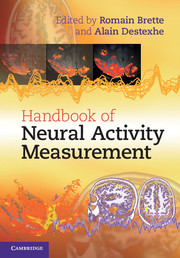Book contents
- Frontmatter
- Contents
- List of contributors
- 1 Introduction
- 2 Electrodes
- 3 Intracellular recording
- 4 Extracellular spikes and CSD
- 5 Local field potentials
- 6 EEG and MEG: forward modeling
- 7 MEG and EEG: source estimation
- 8 Intrinsic signal optical imaging
- 9 Voltage-sensitive dye imaging
- 10 Calcium imaging
- 11 Functional magnetic resonance imaging
- 12 Perspectives
- Plate section
- References
1 - Introduction
Published online by Cambridge University Press: 05 October 2012
- Frontmatter
- Contents
- List of contributors
- 1 Introduction
- 2 Electrodes
- 3 Intracellular recording
- 4 Extracellular spikes and CSD
- 5 Local field potentials
- 6 EEG and MEG: forward modeling
- 7 MEG and EEG: source estimation
- 8 Intrinsic signal optical imaging
- 9 Voltage-sensitive dye imaging
- 10 Calcium imaging
- 11 Functional magnetic resonance imaging
- 12 Perspectives
- Plate section
- References
Summary
Most of what we know about the biology of the brain has been obtained using a large variety of measurement techniques, from the intracellular electrode recordings used by Hodgkin and Huxley to understand the initiation of action potentials in squid axons to functional magnetic resonance imaging (fMRI), used to explore higher cognitive functions. To extract meaningful information from these measurements, one needs to relate them to neural activity, but this relationship is usually not trivial. For example, electroencephalograms (EEG) measure the summed electrical activity of many neurons, and relating the electrical signals of the electrodes to neural activity in specific brain areas requires a deep understanding of how these signals are formed. Therefore, the interpretation of measurements relies not only on an understanding of the physical measurement devices (what physical quantity is measured), but also on our current understanding of the brain (the relationship between the measured quantity and neural activity).
The biophysics of neurons is explained in great detail in a number of books. This book deals with the biophysical and mathematical principles of neural activity measurement, and provides models of experimental measures. We believe this should be useful for at least three broad categories of scientists: (1) neuroscientists who use these techniques in their own experimental protocols and need to interpret the results precisely, (2) computational neuroscientists who use the experimental results for their models, (3) scientists who want to develop new techniques or enhance existing techniques.
Information
- Type
- Chapter
- Information
- Handbook of Neural Activity Measurement , pp. 1 - 7Publisher: Cambridge University PressPrint publication year: 2012
